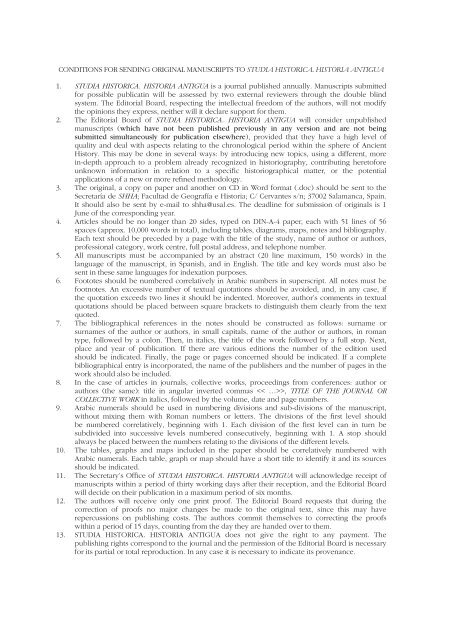Lucio Emilio Paulo y el derecho de guerra - Occidens
Lucio Emilio Paulo y el derecho de guerra - Occidens
Lucio Emilio Paulo y el derecho de guerra - Occidens
Create successful ePaper yourself
Turn your PDF publications into a flip-book with our unique Google optimized e-Paper software.
CONDITIONS FOR SENDING ORIGINAL MANUSCRIPTS TO STUDIA HISTORICA. HISTORIA ANTIGUA<br />
1. STUDIA HISTORICA. HISTORIA ANTIGUA is a journal published annually. Manuscripts submitted<br />
for possible publicatin will be assessed by two external reviewers through the double blind<br />
system. The Editorial Board, respecting the int<strong>el</strong>lectual freedom of the authors, will not modify<br />
the opinions they express, neither will it <strong>de</strong>clare support for them.<br />
2. The Editorial Board of STUDIA HISTORICA. HISTORIA ANTIGUA will consi<strong>de</strong>r unpublished<br />
manuscripts (which have not been published previously in any version and are not being<br />
submitted simultaneously for publication <strong>el</strong>sewhere), provi<strong>de</strong>d that they have a high lev<strong>el</strong> of<br />
quality and <strong>de</strong>al with aspects r<strong>el</strong>ating to the chronological period within the sphere of Ancient<br />
History. This may be done in several ways: by introducing new topics, using a different, more<br />
in-<strong>de</strong>pth approach to a problem already recognized in historiography, contributing heretofore<br />
unknown information in r<strong>el</strong>ation to a specific historiographical matter, or the potential<br />
applications of a new or more refined methodology.<br />
3. The original, a copy on paper and another on CD in Word format (.doc) should be sent to the<br />
Secretaría <strong>de</strong> SHHA; Facultad <strong>de</strong> Geografía e Historia; C/ Cervantes s/n; 37002 Salamanca, Spain.<br />
It should also be sent by e-mail to shha@usal.es. The <strong>de</strong>adline for submission of originals is 1<br />
June of the corresponding year.<br />
4. Articles should be no longer than 20 si<strong>de</strong>s, typed on DIN-A-4 paper, each with 51 lines of 56<br />
spaces (approx. 10,000 words in total), including tables, diagrams, maps, notes and bibliography.<br />
Each text should be prece<strong>de</strong>d by a page with the title of the study, name of author or authors,<br />
professional category, work centre, full postal address, and t<strong>el</strong>ephone number.<br />
5. All manuscripts must be accompanied by an abstract (20 line maximum, 150 words) in the<br />
language of the manuscript, in Spanish, and in English. The title and key words must also be<br />
sent in these same languages for in<strong>de</strong>xation purposes.<br />
6. Foototes should be numbered corr<strong>el</strong>ativ<strong>el</strong>y in Arabic numbers in superscript. All notes must be<br />
footnotes. An excessive number of textual quotations should be avoi<strong>de</strong>d, and, in any case, if<br />
the quotation exceeds two lines it should be in<strong>de</strong>nted. Moreover, author’s comments in textual<br />
quotations should be placed between square brackets to distinguish them clearly from the text<br />
quoted.<br />
7. The bibliographical references in the notes should be constructed as follows: surname or<br />
surnames of the author or authors, in small capitals, name of the author or authors, in roman<br />
type, followed by a colon. Then, in italics, the title of the work followed by a full stop. Next,<br />
place and year of publication. If there are various editions the number of the edition used<br />
should be indicated. Finally, the page or pages concerned should be indicated. If a complete<br />
bibliographical entry is incorporated, the name of the publishers and the number of pages in the<br />
work should also be inclu<strong>de</strong>d.<br />
8. In the case of articles in journals, collective works, proceedings from conferences: author or<br />
authors (the same): title in angular inverted commas >, TITLE OF THE JOURNAL OR<br />
COLLECTIVE WORK in italics, followed by the volume, date and page numbers.<br />
9. Arabic numerals should be used in numbering divisions and sub-divisions of the manuscript,<br />
without mixing them with Roman numbers or letters. The divisions of the first lev<strong>el</strong> should<br />
be numbered corr<strong>el</strong>ativ<strong>el</strong>y, beginning with 1. Each division of the first lev<strong>el</strong> can in turn be<br />
subdivi<strong>de</strong>d into successive lev<strong>el</strong>s numbered consecutiv<strong>el</strong>y, beginning with 1. A stop should<br />
always be placed between the numbers r<strong>el</strong>ating to the divisions of the different lev<strong>el</strong>s.<br />
10. The tables, graphs and maps inclu<strong>de</strong>d in the paper should be corr<strong>el</strong>ativ<strong>el</strong>y numbered with<br />
Arabic numerals. Each table, graph or map should have a short title to i<strong>de</strong>ntify it and its sources<br />
should be indicated.<br />
11. The Secretary’s Office of STUDIA HISTORICA. HISTORIA ANTIGUA will acknowledge receipt of<br />
manuscripts within a period of thirty working days after their reception, and the Editorial Board<br />
will <strong>de</strong>ci<strong>de</strong> on their publication in a maximum period of six months.<br />
12. The authors will receive only one print proof. The Editorial Board requests that during the<br />
correction of proofs no major changes be ma<strong>de</strong> to the original text, since this may have<br />
repercussions on publishing costs. The authors commit thems<strong>el</strong>ves to correcting the proofs<br />
within a period of 15 days, counting from the day they are han<strong>de</strong>d over to them.<br />
13. STUDIA HISTORICA. HISTORIA ANTIGUA does not give the right to any payment. The<br />
publishing rights correspond to the journal and the permission of the Editorial Board is necessary<br />
for its partial or total reproduction. In any case it is necessary to indicate its provenance.


